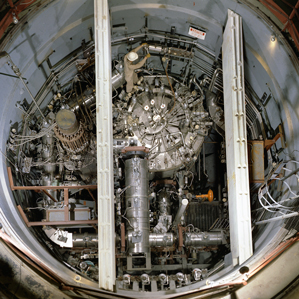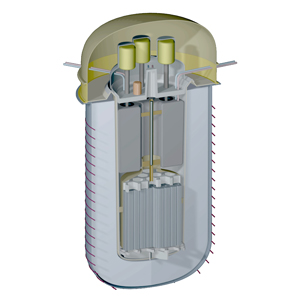Resurrecting a Meltdown-Proof Reactor Design
A new take on an old reactor design could make nuclear power cleaner and safer, and therefore more competitive with fossil fuels.

Terrestrial Energy, a startup in Ontario, Canada, is commercializing the reactor design, which is based on work done at Oak Ridge National Laboratory in Tennessee. Terrestrial plans to start licensing the design in Canada later this year.
Terrestrial is designing a reactor that uses molten salt rather than water as a coolant.
Researchers at Oak Ridge have demonstrated and tested various molten-salt reactors over the past several decades. Terrestrial has modified one of these designs in ways it says will make the technology cheap enough to deploy.
Conventional nuclear reactors cost far more to build than fossil-fuel power plants in large part because of safety regulations stipulating costly redundant pumps, containment structures, and other parts. Terrestrial CEO Simon Irish says the molten-salt design could make it possible to simplify and reduce the cost of safety systems.
In molten-salt designs, if the power goes off or the reactor is damaged, the system will cool off on its own without allowing radioactivity to spread. Conventional nuclear reactors must be actively cooled, with water continuously pumped through them. If the pumps stop, the fuel starts to overheat, which can lead to the release of radioactive materials into the environment.

A handful of other startups, including Transatomic Power, are also working to commercialize molten salt reactors. The technology is also a focus of R&D efforts in China (see “Leslie Dewan: Innovators Under 35” and “Safer Nuclear Power, at Half the Price”).
Terrestrial’s designs are more conventional than those being developed by Transatomic. The company plans to use the same materials employed in reactors tested at Oak Ridge, whereas Transatomic’s designs use several new materials.
In Terrestrial’s reactor, uranium is mixed with a molten-salt coolant. If the fuel gets too hot, that causes the mixture to expand, which slows down fission and reduces the heat of the fuel. This automatically regulates the temperature and prevents overheating. Also, the coolant only boils at a very high temperature, so unlike water, it won’t evaporate even if the pumps stop working.
Furthermore, if the reactor were damaged and the fuel and coolant mixture leaked out, the fission reactions would slow down and the molten fuel would solidify, limiting the spread of radioactive material.
Irish says the design will also reduce nuclear waste by about two-thirds because the reactor operates at temperatures twice as hot as a conventional reactor, which improves its efficiency and reduces the amount of fuel needed. He also says recycling the fuel, which further reduces waste, is simpler than it is with conventional reactors.
To make the Oak Ridge design more practical, Terrestrial modified it so it could be manufactured in a factory and shipped by truck to a power plant site.
Another distinctive feature of Terrestrial’s design is that key parts are disposable. One challenge with the Oak Ridge molten-salt design is that a critical material, graphite, doesn’t last very long, which would mean a plant’s operators would have to regularly replace it. The new design houses the reactor’s main components, including the graphite, in a sealed unit that can be swapped out every seven years, theoretically making operating the plant easier.
Terrestrial has produced a preliminary design, and is working with Oak Ridge to produce an even more detailed design, which an engineering firm could use to produce blueprints. Terrestrial hopes to see the first commercial reactor started in the early part of the next decade.
Keep Reading
Most Popular
Large language models can do jaw-dropping things. But nobody knows exactly why.
And that's a problem. Figuring it out is one of the biggest scientific puzzles of our time and a crucial step towards controlling more powerful future models.
How scientists traced a mysterious covid case back to six toilets
When wastewater surveillance turns into a hunt for a single infected individual, the ethics get tricky.
The problem with plug-in hybrids? Their drivers.
Plug-in hybrids are often sold as a transition to EVs, but new data from Europe shows we’re still underestimating the emissions they produce.
Stay connected
Get the latest updates from
MIT Technology Review
Discover special offers, top stories, upcoming events, and more.